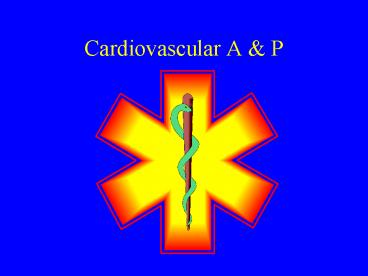Cardiovascular A - PowerPoint PPT Presentation
1 / 30
Title:
Cardiovascular A
Description:
Myocardial muscle is perfused by the coronary arteries. ... Pumping action is rhythmic. Blood is pumped simultaneously from the atria to the ventricles ... – PowerPoint PPT presentation
Number of Views:29
Avg rating:3.0/5.0
Title: Cardiovascular A
1
Cardiovascular A P
2
Cardiovascular AP
3
The Pump
- The heart is a two sided pump used to move blood
from one circuit to another - Two circuits peripheral pulmonary
- Pulmonary circuit oxygenates blood.
- Peripheral circuit distributes the blood.
4
Cardiac Circulation
- Myocardial muscle is perfused by the coronary
arteries. - Coronary arteries originate distal the Aortic
Valve. - Coronary filling is related to diastolic
pressure. - Coronary veins empty the deoxygenated blood into
the right atrium.
5
Vena Cava
Base
LAD
RCA
Apex
6
Physiology
- Right heart is low pressure
- Low pressure allows pulmonary gas exchange
- Pulmonary circuit responsible for Central Venous
Pressure - (4) pulmonary veins flow into the pulmonary trunk
which empties into the left atrium
7
Physiology
- Left heart is high pressure
- Left atrium receives oxygenated blood for
peripheral circulation - Left ventricle larger more muscular
- Cardiac out-put related directly to left
ventricular ejection fraction - Left side seen on ECG due to size
8
Aortic Arch
Pulmonary Veins
Pulmonary Artery
Left Atrium
Right Atrium
Left Ventricle
Right Ventricle
9
Cardiac Cycle
QRS
P
T
depolarization electrical event
contraction physical event
ventricular repolarization
atrial contraction
ventricular contraction
atrial depolarization
ventricular depolarization
10
Cardiac Cycle
- Pumping action is rhythmic
- Blood is pumped simultaneously from the atria to
the ventricles - Volume from the ventricles is equal to that from
the atria - Systole is contraction
- Diastole is relaxation (ventricular filling)
11
Atrial Systole Diastole
- Atrial ventricular filling during diastole
- At the end of the diastolic cycle the atria
contract giving a kick to ventricular filling - Atria are reservoirs for the blood ejected from
the ventricles
12
Ventricular Systole Diastole
- Passive ventricular filling during diastole
followed by atrial kick - AV valves close due to pressure in the ventricles
- Ventricular contraction from apex to base
- Blood prevented from regurgitation into the
ventricles by the aortic pulmonic valves
13
Stroke Volume
- Amount of blood ejected from one ventricle during
one contraction - Dependant on pre-load (end-diastolic volume),
afterload, myocardial contractility - SV(PL (pre-load) CF (contractile force)) - AL
(afterload)
14
Preload
- Stroke volume 70 ml resting
- Preload is pressure of filling the chambers
- Increased preload increases stroke volume
- Increased preload used to perfuse body during
stress
15
Preload is atrial passive filling adding
atrial kick to ventricular filling
16
Afterload is the pressure produced against the
aortic pulmonic valves by the TPVR pulmonary
resistance respectively.
17
Frank-Starling Law
- Muscular out-put determined by stretch of muscle
fibers - Increased pre-load increases stretch therefore
out-put - Preload most important factor of cardiac out-put
- Limit to stretching of the myocardium
- Constant stretching yields myocardial hypertrophy
(cardiomegaly)
18
Afterload
- A result of TPVR
- Has little effect on CO except to cause
regurgitation hypertrophy - Decreased afterload increases SV decreases
cardiac workload / oxygen demand
19
Myocardial Contractility
- Myocardial oxygenation electrolytes have great
affect on contractility - Medications such as Beta Blockers (e.g.
propranolol) hypoxia causes decreased
contractility - Potassium, Calcium, Sodium fluxes cause
derangement to contractility
20
Cardiac Output
- Equal to Stroke volume x heart rate
- The amount of blood pumped by each ventricle each
minute - PVR modifies CO through its effect on SV
- BP is a function of CO PVR
- A rise in either causes a rise in systolic
pressure
21
Left chamber is larger more muscular allowing
greater pump pressure. Cardiac out-put may be
decreased by dysfunctional valves allowing
regurgitation of blood back into the chambers.
22
Nervous System Control
- Control by both the central peripheral nervous
system - Checks balances by sympathetic
parasympathetic systems - Controls contractility, conduction, heart rate
23
Parasympathetic Control
- Main nerve is the Vagus (10th cranial nerve)
mediated by ACh - Causes a decrease in heart rate contractility
- Vagal stimulation by Valsalva, carotid sinus
massage, NV, pain, distention of urinary
bladder - Greater effect of HR than SV
24
Sympathetic Control
- Nerve ganglia originate in the thorax C-spine
- Post-ganglionic nerve mediator Norepinephrine
- Heart rate (chronotrophy) contractile force
(inotrophy) - Dilation of coronaries constriction of
peripheral vasculature increases myocardial
oxygen availability
25
Sympathetic Control
- Alpha Beta receptors
- Few alpha cell receptors on the heart
- Primarily Beta receptors causing increased HR
contractility - Alpha effects in the peripheral vasculature
causing increased TPVR thus increased BP - Over stimulation of the HR leads to inadequate
ventricular filling decreased SV
26
Hormonal Regulation
- Increased levels of Epinephrine Norepinephrine
are caused by increased demand - Epinephrine inotrophe chronotrophe
- Norepinephrine inotrophe chronotrophe
- Alpha effects cause increased TPVR decreased
renal output - Beta effects cause increased HR, BP, bronchial
dilation.
27
Electrolytes
- Contraction stimulation controlled by
electrolytes - Magnesium ICF cation important for nervous
transmission - Calcium, Sodium, Potassium important at the
cellular level for nerve transmission muscular
contraction
28
(No Transcript)
29
Stay tuned for electrophysiology of the
heart.
30
(No Transcript)































